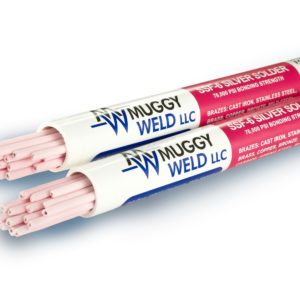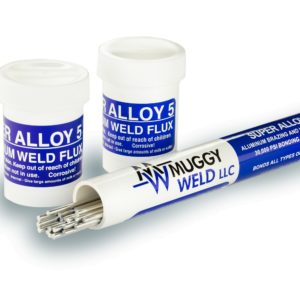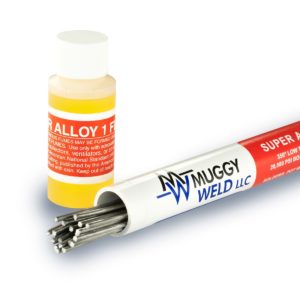Butt welding with Super Alloy 5 is one of the easiest methods for joining two pieces of aluminum.
What exactly is a butt weld? By definition, a butt joint is created when two pieces are joined on the same plane. While many welders use TIG or MIG when welding a butt joint, we believe torch welding butt joints is superior for a few reasons:
- Brazing butt joints with Super Alloy 5 eliminates porosity commonly found in arc welded joints
- The use of flux allows for better penetration, and therefore a stronger bond
- Brazing eliminates slag produced by arc electrodes, leaving a cleaner finished product
To demonstrate butt welding with Super Alloy 5, we placed 2 aluminum plates side by side and filled the gap with Super Alloy 5. This particular butt weld is called a single square groove because both pieces are identical in size and aligned. It’s necessary to leave a small gap between the aluminum pieces, to enable the Super Alloy 5 to penetrate the joint front to back.
Important note: Always keep the torch moving to avoid overheating the aluminum. We used a propane torch, but oxyacetylene would be just as effective (especially with thicker aluminum)
Brazing with Super Alloy 5 enables the welder to create the butt joint without pre-cleaning the aluminum, as the flux removes all oxidation. This unique flux also acts as a temperature guide, liquefying when the base metal has reached 600°F, indicating the proper working temperature.
Once the aluminum plates have reached 600°F, the filler rod is applied by laying the rod flat and melting a piece into the groove. Continue moving the torch and applying flux until the joint has been successfully created and the rod had flattened smooth.
When the butt weld is complete, allow the part to cool naturally, then remove excess flux with warm water and a wire brush. It’s that simple.
TIPS:
- The flux is important. Super Alloy 5’s flux ensures an air-tight, water-tight bond, and increases the flow of the rod.
- With this butt welding application, it’s important to keep the torch at an angle perpendicular to the joint.
- If the rod balls up, your base metal is too cold. Knock the ball off, back the rod up, and add more flux and heat until the flux liquefies, then reapply rod.
Note: Please observe all AWS Safety & Health Guidelines when using Muggy Weld products.
Check Out These Products
-

Silver Solder Rod: Flux-Coated SSF-6 56% Brazing Rod
$69.00 – $260.00High-Strength, 56% Silver Solder Rod🌡 Melting Temperature 1150 / 621 ⇄︎ Bonding Strength 70000 psi, 482.63 MPa 🔧︎ Sizes Available (in) 1/16 🔧︎ Sizes Available (mm) 1.58 -

Super Alloy 5 Aluminum Welding and Brazing Rod
$69.00 – $109.00600°F aluminum welding, brazing, and soldering rod. Ideal for aluminum boat repair and cast aluminum.🌡 Melting Temperature 600 / 317 ⇄︎ Bonding Strength 30000 psi, 206.84 MPa

